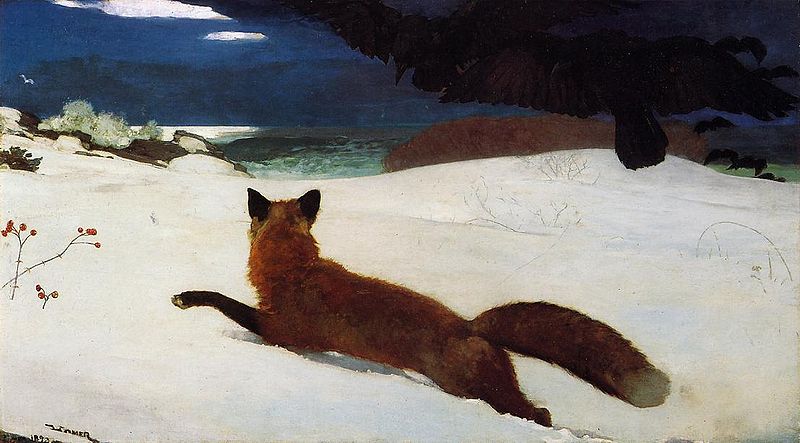We headed up to Portland, Maine for the day to visit an art museum, a fine old Victorian home decorated for Christmas, and the old Wadsworth Longfellow homestead.
Near our parking spot, a sticker left over (perhaps) from the recent election:
 |
| Nobody was my first choice for president in this election. But I voted for someone else anyway. |
The PMA audio guide to Fox Hunt stated that the fox is tiring in the deep snow and that he is wearily looking over his shoulder as he runs. This is consistent with the contemporary commentaries as shown on page 381 of Winslow Homer 1836-1910, by Nicolai Cikovsky, Jr., and Franklin Kelly:
A wretched fox, driven from his lair by frost and famine, struggles through the heavy drifts in quest of food; and over him, circling nearer and nearer, as he grows weaker and weaker, come the ravens [sic] who are soon to pluck his bones. [citation: Alfred Trumble, "Facts, Ideas, and Opinions," The Collector 4 (1 April 1893), 166]
The fox's condition is also referred to here:
The subject ... requires a word of explanation as to the fact in natural history of which it is a dramatic illustration. In the depths of winter, when the ground is for long intervals covered with snow along the coast of Maine, it is observed that a flock of half-starved crows will have the temerity to attack a fox, relying on their advantage of numbers, the weakened condition of the fox and the deep snow, which makes it the more difficult for the victim to defend himself. [citation: "Winslow Homer's Latest Picture, 'The Fox Hunt,' at Doll & Richards'," Boston Evening Transcript, 30 June 1893]
Although the online notes at the Pennsylvania Academy of the Fine Arts do not focus as much on the fox's physical condition, they still characterize the fox as "struggling"and "desperate[]":
[Homer] dramatized the brutal realities of winter on the Maine coast by showing a fox desperately bounding through deep snow in an attempt to flee a flock of half-starved crows. The birds descend ominously with outstretched wings, forming a dark hovering mass above the struggling fox. ... The fox's red silhouette is splashed across a field of oppressive snow; we sense that he is cornered, trapped within the flattened white plane while the aggressive birds break its edges on descent.
Perhaps we are to infer his deteriorated physical condition from the fact that the crows have targeted him. That's possible, but it could also be that the crows are sufficiently motivated to attack him even if he is not yet weakened (i.e., while he was out and about on his usual winter prowls and forays for food). I also found myself wondering if the crows might be taking advantage of a human-led fox hunt, rather than launching their own -- though I'm not sure that we have much of a fox hunting tradition here in the U.S.
(As a side note, Homer was supposedly painting from death - the pelt of a fox and the bodies of crows - and actually re-did the bird figures after a neighbor told him they did not look like crows.)
I thought we'd visited the museum before, but they've apparently remodeled since we last visited together in July 2007, so I wasn't totally sure until I saw this painting:
 |
| N.C. Wyeth |
Afterward, we headed up to Victoria Mansion a/k/a the Morse-Libby House, decorated for Christmas by a variety of local merchants according to this year's theme, "The Gilded Age". Yes, there was a bit of glitz.
I liked this stained glass at the stairwell:
In one of the upstairs bedrooms, there was a nearly hyper-realistic painting of an infant. The setting is truly minimalist: she sits on a bare floor, with a single dark drapery panel in the background. She dominates the portrait, gazing at the viewer. She holds two roses in her hand. A docent explained that these were standard conventions for a portrait of a deceased child. In fact, the body was painted in advance, with only the face customized based on the family's descriptions. That seemed consistent with what we saw.
Finally, we went to an exhibit about the electrification of Maine to pass the time while waiting for a tour of the Wadsworth-Longfellow House. From the website:
Anne Longfellow Pierce, Henry [Wadsworth Longfellow]'s younger sister ... lived in the house until her death in 1901. At that time, in accordance with a deed she executed in 1895, the house passed to the Maine Historical Society to be preserved as a memorial to her famous brother and their family.
Virtually all of the household items and artifacts are original to the Wadsworth and Longfellow families.Apparently, Anne agreed that the Maine Historical Society could electrify and heat the home after her death, but strongly opposed any indoor plumbing or other alterations. They have abided by these wishes.
It was interesting to see the place, but I was a bit skeptical of statements announcing (in effect) "this was the very desk where Henry composed" a particular poem. Even if true, I hardly imagine the desk has been imbued with particular greatness as a result.




No comments:
Post a Comment